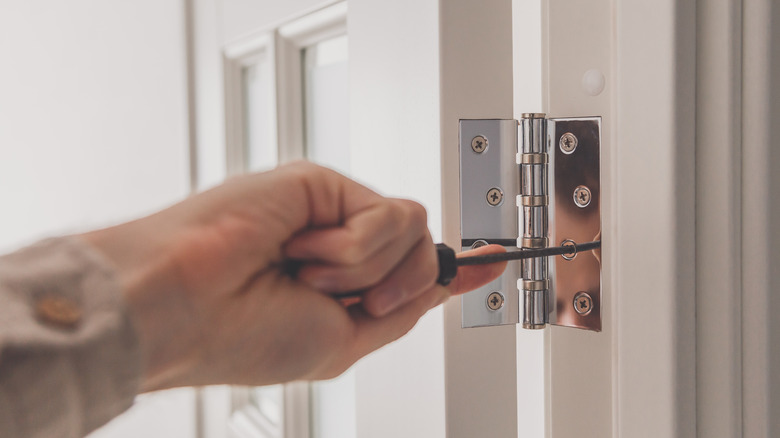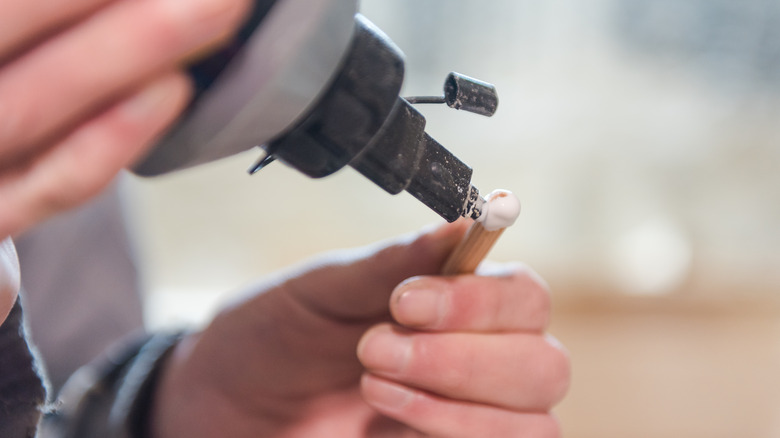How To Repair A Loose Screw With A Wooden Match (The Way Grandpa Did)
The collection of things people have tried shoving in a stripped screw hole to fix it is almost identical to the set of things that will fit in a stripped screw hole. It would surprise no denizen of DIY home repair forums to find someone filling a screw hole with linguine or strips of fabric softener sheets. But obviously, some solutions are better than others, and TikTokker @treysimulator turns to a classic approach from the lore of woodworking and home repair: break the heads off some wooden matches, stick as many as you can in the hole, and put the screw back in. You have to have a screw loose to need or heed such advice, but it works pretty well.
What's happening inside a stripped screw hole is that the force pulling the screw outward has effectively scraped out the material that screw threads were gripping onto, leaving the screw held in place only by the power of positive thinking. The solution is to introduce new material for the threads to get purchased in, and in the rarefied world of proper woodworking where people wear aprons and sharpen chisels that usually means gluing a plug or a dowel into the hole, cutting it flush, drilling a pilot hole, and replacing the screw. Could grandpa's method of shoving some matchsticks in there work as well?
Matchsticks, and everything else, work great
Long-standing hacks in hobbies like woodworking and trades like construction survive because they do work most of the time. It's not so much that matchsticks are the ideal filler material; you'll get equally passionate, and equally old, advice suggesting you use toothpicks, slivers of scrap wood, or a paste of wood glue and sawdust. They all work pretty well because they all operate by the same principle: give the threads some bite, and they'll bite. There are newer suggestions that reportedly work as well — golf tees, pencils, those fluted dowels that help hole IKEA furniture together, wooden skewers, and disposable chopsticks to name a few. But there are many more options for repairing a stripped screw hole before you're reduced to trying linguine.
Another reason that matchsticks work well is that their angular, irregular edges provide some additional resistance to turning within the hole and that turning can undermine the threading. Matchsticks, like fluted dowels and hexagonal pencils, might have another advantage that illustrates the secret to converting your in-a-pinch quick fix into a perfectly strong solution. They allow you to bring some glue into the picture without scraping it all away in the process.
Moving from strong to strongest
Standard PVA wood glue is shockingly strong stuff — usually stronger than the wood being glued — and adding a dollop to the stripped hole usually makes the matchstick solution about as strong as anything else would. The difference between gluing an unpainted golf tee and a traditional dowel into the hole is negligible, if there's any difference at all. CA glue like Super Glue will help as well, and Fine Woodworking's trick of strengthening screw holes with epoxy can be extended to repairing stripped holes as well.
In some circumstances, the simplest (and plenty strong) approach is to just use a different screw. A longer or wider screw can be very strong if it has enough material to grab onto, as is often the case with hinges (which tend to strip their holes by the weight they support). Door frames are often supported by adjacent framing lumber, so longer screws can be used to make the hinge much stronger. Using longer screws for door hinges and strikeplates is one DIY way to make your home safer. The only thing to watch out for is that the screw head shouldn't be any larger than the original, or it might not seat properly in the countersunk hole in the hinge.

